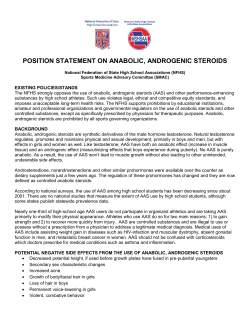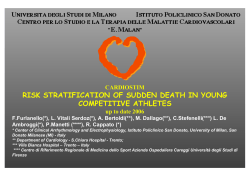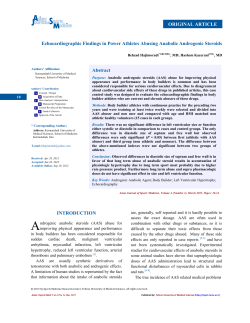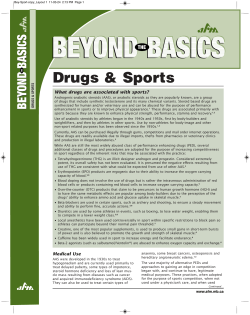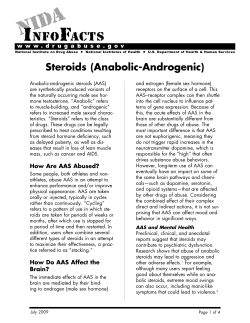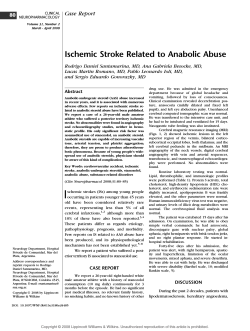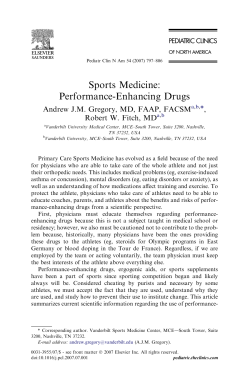
Doping and effects of anabolic androgenic steroids on the heart: histological,
Human & Experimental Toxicology (2009) 28: 273–283 www.het.sagepub.com Doping and effects of anabolic androgenic steroids on the heart: histological, ultrastructural, and echocardiographic assessment in strength athletes NA Hassan1, MF Salem2 and MAEL Sayed3 1Departments 2Departments of Forensic Medicine and Toxicology, Faculty of Medicine, Tanta University, Egypt; of Anatomy, Faculty of Medicine, Tanta University, Egypt; and 3Departments of Cardiology, Faculty of Medicine, Tanta University, Egypt Anabolic androgenic steroids (AAS) are used by some athletes to enhance performance despite the health risk they may pose in some persons. This work was carried out to evaluate the possible structural and functional alterations in the heart using two-dimensional, M-mode, tissue Doppler imaging (TDI) and strain rate imaging (SRI) in athletes using supraphysiological doses of AAS. Additionally, the histological and ultrastructural changes in cardiac muscles of adult albino rats after injection of sustanon, as an example of AAS, were studied. Fifteen male bodybuilders using anabolic steroids constituted group 1, five male bodybuilders who are not using anabolic steroids constituted group 2, and five nonathletic males constituted negative control group (group 3). They were investigated by two-dimensional, M-mode, TDI and SRI. This study was performed on 30 adult albino rats. They were divided into two groups. Group I (Control group) (10) was subdivided into negative control, subgroup 1a (5), and subgroup 1b (5), which received 0.8 ml olive oil intramuscular once a week for 8 weeks. Group II (Experimental group) (20) received sustanon 10 mg/kg intramuscularly once a week for 8 weeks. The heart spe- cimens were prepared for light microscopy and transmission electron microscopy. Echocardiographic results showed that bodybuilders who use steroids have smaller left ventricular dimension with thicker walls, impaired diastolic function, as well as higher peak systolic strain rate in steroid-using bodybuilders as compared to the other two groups. Light microscopy examination of cardiac muscle fibers showed focal areas of degeneration with loss of striations and vacuolation in the experimental group. Ultrastructural examination showed disturbance of the banding pattern of the cardiac muscle fiber with disintegration, loss of striations, dehiscent intercalated disc, and interrupted Z-bands. Administration of supraphysiological doses of AAS caused severe deleterious effects in the myocardium both in athletes and in experimental animals. The SRI shows promise in the early detection of systolic dysfunction in those athletes who use steroids. Introduction diuretics, and agents with an antiestrogenic activity.1 Exercise is a potent cardiac hypertrophic stimulus. Meanwhile, athletes expose themselves to supraphysiological doses of anabolic androgenic steroids (AAS) to increase skeletal muscle mass and strength effects, which form the basis for their administration to enhance athletic performance. A variety of AAS are often taken simultaneously (so-called “stacking”) and in doses that result in 10–100-fold increases in androgen concentrations.2 Recently, among the numerous documented toxic and hormonal effects of AAS, attention has been focused on the cardiovascular effects of AAS2 as it is strongly associated with detrimental cardiovascular The use of drugs to improve athletic performance is known as doping, which is prohibited by antidoping rules and may pose a health risk to some persons. The list of illicit drugs banned by the International Olympic Committee and yearly updated by the World Anti-Doping Agency includes the following classes: stimulants, narcotics, anabolic agents (androgenic steroids and others such as β-2 stimulants), peptide hormones, mimetics and analogs, Correspondence to: Neven Ahmed Hassan (Assistant Professor of Forensic Medicine and Toxicology), Departments of Forensic Medicine & Toxicology, Faculty of Medicine, Gharbia governorate Tanta University, Egypt. Email: neven_prof@yahoo.com Key words: androgenic anabolic steroids; doping; heart; tissue Doppler imaging © The Author(s), 2009. Reprints and permissions: http://www.sagepub.co.uk/journalsPermissions.nav 10.1177/0960327109104821 Doping and effects of anabolic androgenic steroids on the heart NA Hassan, et al. 274 effects, including elevation of blood pressure, depression of high density lipoprotein (HDL), and sudden cardiac death.3 In some cases, infarction has occurred without evident coronary thrombosis or atherosclerosis, leading to the hypothesis that AAS may induce coronary vasospasm and cardiac arrhythmias in susceptible individuals. Similarly, there are several case reports of increased thromboembolic risk.4 Therefore, in the management of arrhythmic athletes, the cardiologist should always consider the possibility that the arrhythmias may be due to the consumption of illicit drugs (sometimes more than one type), especially if no signs of cardiac diseases are apparent. However, in the presence of latent underlying arrhythmogenic heart disease including some inherited cardiomyopathies at risk of sudden cardiac death, illicit drugs could induce severe cardiac arrhythmic effects.1 Supraphysiological doses of anabolic steroids, whether taken during exercise training or under sedentary conditions increase myocardial susceptibility to ischemia/reperfusion injury. This increased susceptibility may be related to steroid-induced increases in the pre-ischemic myocardial cAMP concentrations and/or increases in both pre-ischemic and reperfusion tumor necrosis factor (TNF)-α concentrations.3 Strain and strain rate (SR) are measures of deformation that are basic descriptors of both the nature and the function of cardiac tissue. These properties may now be measured using either Doppler or twodimensional ultrasound techniques. Echocardiographic strain rate imaging (SRI) has been applied for the assessment of resting ventricular function, the assessment of myocardial viability using lowdose dobutamine infusion, as a stress testing for ischemia. Resting function assessment has been applied in both the left and the right ventricles and may prove particularly valuable for identifying myocardial diseases and for following up the treatment response.5 The effects of AAS on left ventricular (LV) structure and function in strength-trained athletes are still controversial. Therefore, this study was done to evaluate the effects of regular AAS administration in athletes using two-dimensional, M-mode, tissue Doppler imaging (TDI) and SRI to detect possible structural and functional alterations in the heart. Experimental study of the cardiac muscles (histological and ultrastructural changes) was carried out in this study on adult albino rats under the effects of anabolic steroids administration. Subjects and methods Twenty-five healthy adult males of comparable age were examined after written consent and divided into three groups: Group 1 consisted of 15 experienced adult male bodybuilders who used AAS regularly in the form of intramuscular testosterone (250 mg) once weekly for a period ranging from 3 to 5 years with a history of intensive, long-term strength training with body weight between 100 and 130 kg. Group 2 consisted of five adult male bodybuilders who do not use AAS. Group 3 consisted of five adult nonathletic normal males who served as control group. All cases were examined by the following: 1) Echocardiography (GE Vivid 7 Dimension, M4S probe) was used for the measurement of LV internal dimensions and wall thickness from M-Mode with automatic estimation of ejection fraction (EF) as described by Feigenbaum.6 LV mass was calculated according to the area/length method described by Schiller, et al.7 in which epicardial and endocardial areas were determined in the para-sternal short axis view at the level of the papillary muscle both at systole and diastole and then LV length is determined from apical four chamber both at systole and diastole. LV mass is automatically calculated using a special built-in software and then it was corrected to the body surface area. 2) Conventional Doppler study of the mitral valve and Tissue Doppler wave velocities were measured from the lateral mitral annulus in all subjects. The following waves were measured: systolic wave SM, and two diastolic waves, EM, and AM. 3) SRI is acquired from the tissue velocity imaging mode, frame rates varied from 99 to 134 fps, with a mean value of 116. Analysis was performed offline using the built-in Q analysis software to measure peak systolic strain rate (PSSR) as the maximal negative SR within 350 ms after the QRS complex. It was evaluated for midseptal region from the apical four chamber view in all 25 subjects included in the study. A region of interest (ROI) was placed in the basal part of midseptum halfway between the endocardium and epicardium. Auto-correction of ROI location during systolic contraction accounted for the inward Doping and effects of anabolic androgenic steroids on the heart NA Hassan, et al. 275 motion of the ventricular wall to keep the ROI halfway between the endocardium and epicardium. Three consecutive beats were analyzed, and the mean was calculated. PSSR < −0.9 is considered normal.8 Material and methods Chemical Sustanon ampoule (1 ml testosterone undecanoate) was purchased from Sedico, which contained 250 mg/ml dissolved in 100 ml olive oil. Each rat was given 0.8 ml of that aliquot/week for 8 weeks. Animals and treatment This study was performed on 30 adult albino rats (7 weeks old), regardless the sex and weighed 200 g. They were fed the usual diet with free water supply and were kept in good hygienic conditions. They were divided into two groups: Group I (Control group) consists of 10 rats. It was divided into two subgroups, five rats for each: ° Subgroup (1a): Rats in subgroup (1a) served as negative control and took no medication. ° Subgroup (1b): Rats in subgroup (1b) were injected intramuscularly with 0.8 ml olive oil once a week for eight consecutive weeks. Group II (Experimental group) consists of 20 rats. Each rat was injected with 10 mg/kg sustanon intramuscularly once a week (1/100 of LD50) for 8 weeks.9 Tissue collection and preparation At the appropriate date of the experiment, animals were sacrificed under ether anesthesia. The heart specimens were taken from the anterior-lateral wall of the left ventricle near the apex.10,11 The heart specimens were prepared for light microscopy and transmission electron microscopy examination. 1) Light microscopy study: The specimens were excised and fixed in 10% formolsaline and embedded in paraffin. Serial sections of 5–7 μm thickness were cut and stained with Hematoxylin and Eosin (H&E) and examined by light microscopy for general histological features.12 2) Ultrastructural study: Ultra-thin sections (0.4– 0.5 μm) were fixed in 1% phosphate buffered glutraldhyde (pH 7.2–7.4). The specimens were stained with 4% uranyl acetate and lead citrate. The grids were then examined and photographed with transmission electron microscope (Philips 400) in the electron microscopy unit of Ain Shams University.13 Statistics Data were analyzed using Microsoft Excel sheets. Descriptive data are expressed as mean ± standard deviation; variables in the three groups were compared using ANOVA test and variables in each of the two groups were compared using Student’s t-test. P < 0.05 is considered significant. Body surface area is measured as BSA = (W 0.425 × H 0.725) × 0.007184, where W is weight in kilograms and H is height in centimeters.14 Results Subjects’ examination The mean age of the subjects included in this study was 32 ± 4. Systolic arterial blood pressure (SBP) increase was not significant in group 1 (132 ± 12) when compared to group 2 (130 ± 10) and group 3 (128 ± 8). There were no significant differences in diastolic blood pressure (DBP) of group 1 (78 ± 4) when compared to group 2 (77 ± 3) and group 3 (75 ± 7) at P = 0.23. The heart rate (HR) was significantly lower in group 1 and 2 as compared to group 3 (P < 0.05) (Table 1). Echocardiographic parameters As presented in Table 2, the end systolic dimensions (ESD) were significantly smaller in group 1 (2.6 ± 0.29), as compared to group 2 (2.0 ± 0.11) and group 3 (3.06 ± 0.08), at P < 0.0001. Table 1 Hemodynamics of the subjects included in the three groups Group SBP DBP HR 1 (anabolic steroid group) 2 (nonusers athletes) 3 (control nonathletes) Significance 132 ± 12 130 ± 10 128 ± 8 Non significant 78 ± 4 77 ± 3 75 ± 7 Non significant 66 ± 5 67 ± 2 75 ± 5 Significant SBP, systolic blood pressure; DBP, diastolic blood pressure; HR, heart rate. Group 1, athletes using anabolic steroids; group 2, athletes who do not use anabolic steroids; group 3, control group (nonathletes). Doping and effects of anabolic androgenic steroids on the heart NA Hassan, et al. 276 Table 2 Echocardiographic parameters examined in the three groups Echocardiographic parameters Group 1 (N = 15) Group 2 (N = 5) Group 3 (N = 5) End systolic dimensions End diastolic dimensions Interventricular septal dimensions Left ventricular posterior wall Left ventricular ejection fraction Left ventricular mass 2.6 ± 0.29 4.6 ± 0.3 1.06 ± 0.08 1.07 ± 0.09 72 ± 8 212 ± 12 2.9 ± 0.11 5 ± 0.1 0.8 ± 0.07 0.88 ± 0.08 60 ± 0.7 165 ± 3 3.06 ± 0.08 5.06 ± 0.08 0.76 ± 0.11 0.8 ± 0.11 61 ± 1.3 163 ± 2.5 The end systolic dimensions (ESD) were significantly smaller in group 1 (2.6 ± 0.29), as compared to group 2 (2.9 ± 0.11) and group 3 (3.06 ± 0.08), at P < 0.0001. The end diastolic dimensions (EDD) were significantly smaller in group 1 (4.6 ± 0.3), as compared to group 2 (5 ± 0.1) and group 3 (5.06 ± 0.08), at P = 0.0004. In the same figures, interventricular septal dimensions (IVS) were significantly thicker in group 1 (1.06 ± 0.08), as compared to group 2 (0.8 ± 0.07) and group 3 (0.76 ± 0.11), at P = 0.007. Left ventricular posterior wall (LVPW) was significantly thicker in group 1(1.07 ± 0.09), as compared to group 2 (0.88 ± 0.08) and group 3 (0.8 ± 0.11), at P = 0.009. Left ventricular ejection fraction (LV EF) was significantly higher in group 1 (72 ± 8), as compared to group 2 (60 ± 0.7) and group 3 (61 ± 1.3), at P < 0.001. In Figures 10–12, left ventricular mass was significantly bigger in group 1(212 ± 12), as compared to group 2 (165 ± 3) and group 3 (163 ± 2.5), at P < 0.001. After correction of LV mass to the body surface area, corrected LV mass is still significantly higher in group 1(129 ± 15) as compared to group 2 (97 ± 2) and group 3 (96 ± 1.5) at P < 0.05, whereas it showed no change between groups 2 and 3, P = 0.23. Transmitral Doppler flow results All subjects in group 1 showed impaired relaxation as proved by short E wave, tall A wave, and reduced E/A < 1 (Table 3). Tissue Doppler parameters All subjects in group 1 have shown impairment of diastolic function. This was evidenced by the following: significant decrease in EM velocities in group 1 (7.3 ± 1.6 cm/s), as compared to its level in group 2 (13.5 ± 4.6 cm/s) and group 3 (15.9 ± 4 cm/s), at P = 0.039 and significant increase in AM velocity in MASS in the three groups p=s p=s 300 MASS in gram The end diastolic dimensions (EDD) were significantly smaller in group 1 (4.6 ± 0.3), as compared to group 2 (5 ± 0.1) and group 3 (5.06 ± 0.08), at P = 0.0004. In the same table, interventricular septal dimensions (IVS) were significantly thicker in group 1 (1.06 ± 0.08), as compared to group 2 (0.8 ± 0.07) and group 3 (0.76 ± 0.11), at P = 0.007. Left ventricular posterior wall (LVPW) was significantly thicker in group 1 (1.07 ± 0.09), as compared to group 2 (0.88 ± 0.08) and group 3 (0.8 ± 0.11), at P = 0.009. Left ventricular ejection fraction (LV EF) was significantly higher in group 1 (72 ± 8), as compared to group 2 (60 ± 0.7) and group 3 (61 ± 1.3), at P < 0.001. In Figure 1, LV mass was significantly bigger in group 1 (212 ± 12), as compared to group 2 (165 ± 3) and group 3 (163 ± 2.5), at P < 0.001. After correction of LV mass to the body surface area, corrected LV mass is still significantly higher in group 1 (129 ± 15) as compared to the other two groups, group 2 (97 ± 2) and group 3 (96 ± 1.5), at P < 0.05, whereas it showed no change between groups 2 and 3, P = 0.23 (Figure 2). The previous echocardiographic parameters showed that LV internal dimensions were significantly smaller but wall thickness, EF, and mass were significantly higher in group 1 as compared to groups 2 and 3. There was no significant difference between athletes who do not use drugs in group 2 and the normal control in group 3. 250 p=ns 200 150 100 50 0 1 2 3 Figure 1 Comparison between left ventricular (LV) mass in the three groups. LV mass was significantly higher in group 1 as compared to groups 2 and 3. There was no significant difference between athletes who do not use drugs in group 2 and the normal control in group 3. S, significant; NS, not significant; group 1, athletes using anabolic steroids; group 2, athletes who do not use anabolic steroids; group 3, control group (nonathletes). Doping and effects of anabolic androgenic steroids on the heart NA Hassan, et al. 277 Table 4 SM, EM, and AM in the three groups 160 mass in gm/cm2 140 120 100 80 p=s 60 p=ns 40 20 0 2 groups 1 3 Figure 2 Comparison between corrected left ventricular (LV) mass in the three groups. After correction of body mass, LV mass was significantly higher in group 1 as compared to groups 2 and 3. There was no significant difference between athletes who do not use drugs in group 2 and the normal control in group 3. S, significant; NS, not significant; group 1, athletes using anabolic steroids; group 2, athletes who do not use anabolic steroids; group 3, control group (nonathletes). group 1 (10.6 ± 1.8 cm/s), as compared to group 2 (8.8 ± 1.2 cm/s) and group 3 (9 ± 0.7 cm/s), at P = 0.006. However, SM wave did not exhibit any significant difference among the three groups (8.4 ± 2.9 cm/s in group 1, 9.1 ± 2.7 cm/s in group 2, and 10 ± 2 in group 3), at P = 0.6 (Table 4, Figures 3–5). SR results PSSR is significantly higher in group 1 (−0.7 ± 0.13) as compared to groups 2 and 3 (−1.3 ± 0.25 and −1.29 ± 0.26, respectively) (Table 5, Figures 6–8). Experimental results During the 8 weeks period of intramuscular injection of sustanon in rats, aggressive behavior was observed followed by inactive behavior as evidenced by lack of locomotion upon stimulation. Groups SM EM AM 1 2 3 8.4 ± 2.9 9 ± −2.7 10 ± 2.2 7.34 ± 1.6 13.52 ± 4.64 15.92 ± 4.02 10.69 ± 1.8 8.18 ± 1.26 9 ± 0.70 All subjects in group 1 showed impaired diastolic function as there were significantly lower EM velocities 7.3 ± 1.6 cm/s in group 1, 13.5 ± 4.6 in group 2 and 15.9 ± 4 in group 3, at P = 0.039 and significantly higher AM velocity 10.6 ± 1.8 in group 1, 8.8 ± 1.2 in group 2 and 9 ± 0.7 in group 3, at P = 0.006. SM wave did not show any significant difference among the three groups 8.4 ± 2.9 in group 1, 9.1 ± 2.7 in group 2, and 10 ± 2 in group 3 at P = 0.6 Group 1, athletes using anabolic steroids; group 2, athletes who do not use anabolic steroids; group 3, control group (nonathletes). Light microscopy examination Control group Longitudinally cut fibers of rat LV wall specimens stained with H&E stain were found to be formed of the cardiac myofibers with its branched pattern; the nuclei of the cardiac myocytes contained acidophilic sarcoplasm with large, oval, vesicular, centrally located nuclei and surrounded by a clear zone. Also, the connective tissue between these fibers contained elongated nuclei of the endothelial and fibroblasts cells (Figure 9). Specimens of the control group, administered with olive oil intramuscularly, showed similar findings as that of the previous group. Experimental group After intramuscular injection of 0.8 ml sustanon/week for 8 weeks, sections of the 25 EM wave among the thre groups p=s 20 cm/s corrected LV mass p=s p=s p=ns 15 10 Table 3 Transmitral Doppler parameters of the three groups Groups E A E/A 1 2 3 Significance 65 ± 12 85 ± 16 86 ± 16 Significant 83 ± 13 56 ± 12 63 ± 11 Significant 0.79 ± 0.06 1.5 ± 0.2 1.3 ± 0.04 Significant All subjects in group 1 showed impaired relaxation as proved by short E wave, tall A wave, and reduced E/A < 1. Group 1, athletes using anabolic steroids; group 2, athletes who do not use anabolic steroids; group 3, control group (nonathletes). 5 0 1 2 3 Figure 3 EM velocity among the three groups. All subjects in group 1 showed impaired diastolic function as there were significantly lower EM velocities 7.3 ± 1.6 cm/s in group 1, 13.5 ± 4.6 in group 2 and 15.9 ± 4 in group 3, at P = 0.039. S, significant; NS, not significant; group 1, athletes using anabolic steroids; group 2, athletes who do not use anabolic steroids; group 3, control group (nonathletes). Doping and effects of anabolic androgenic steroids on the heart NA Hassan, et al. 278 Table 5 Peak systolic strain rate (PSSR) values in the three groups AM among the three groups p=s p=s 14 12 p=ns cm/s 10 8 6 4 2 0 1 2 3 Figure 4 AM velocity among the three groups. AM velocity was significantly higher 10.6 ± 1.8 in group 1, 8.8 ± 1.2 in group 2 and 9 ± 0.7 in group 3, at P = 0.006. S, significant; NS, not significant; group 1, athletes using anabolic steroids; group 2, athletes who do not use anabolic steroids; group 3, control group (nonathletes). cardiac muscle fibers showed focal areas of degeneration with loss of striations. Also, the fibers showed destructions of the sarcolemmal membrane in some areas. Some fibers showed alternating patchy stained fibers and others appeared degenerated, pale stained, and enucleated. The nuclei of the cardiac myocytes were dispersed by karyolysis and others were invisible (Figure 11A,B). After intramuscular injection of 0.8 ml sustanon/ week for 8 weeks, transversally cut fibers of rat LV wall specimens appeared with central pyknotic nuclei in some fibers and others were completely devoid of the nuclei. Sarcoplasmic vacuolation and inflammatory cellular infiltrations were obvious (Figure 11C). Patients Group 1 Group2 Group 3 1 2 3 4 5 6 7 8 9 10 11 12 13 14 15 Mean SD −1.1 −1 −0.9 −0.8 −0.7 −0.7 −0.6 −0.7 −0.8 −0.7 −0.8 −0.7 −0.6 −0.7 −0.8 −0.77333 0.138701 −1 −1.2 −1.3 −1.6 −1.5 −1.6 −1.3 −1.1 −0.96 −1.5 −1.32 0.25 −1.292 0.267058 PSSR is significantly higher in group 1 as compared to the other groups with the mean values −0.7 ± 0.13, −1.3 ± 0.25, and −1.29 ± 0.26 in groups 1, 2, and 3, respectively. Group 1, athletes using anabolic steroids; group 2, athletes who do not use anabolic steroids; group 3, control group (nonathletes). Ultrastructural examination Control group Ultra-thin sections of the rat LV wall specimens clarified that sarcomeres formed the structural units of the cardiac muscle fibers. The myofibrils that arranged in between the two Z lines with (A) band (dark band in the middle) and (I) band (light band at the periphery) appeared in register. The mitochondria in the sarcoplasm were seen arranged in rows or columns between the myofibrils with regular outline and obvious cristae. Also, cardiac myocytes appeared attached end-to-end by intercalated discs with stepwise arrangement of PSSR in the groups S wave among the three groups 0.2 p=ns 12 0 10 -0.2 8 1/s cm/s 14 6 -0.4 -0.6 -0.8 4 -1 2 0 p=s 0.4 p=ns p=s 1 -1.2 1 2 3 -1.4 2 3 groups Figure 5 SM velocity among the three groups. SM wave did not show any significant difference among the three groups. 8.4 ± 2.9 in group 1, 9.1 ± 2.7 in group 2, and 10 ± 2 in group 3 at P = 0.6. S, significant; NS, not significant; group 1, athletes using anabolic steroids; group 2, athletes who do not use anabolic steroids; group 3, control group (nonathletes). Figure 6 Peak systolic strain rate (PSSR) is significantly higher in group 1 as compared to the other two groups. S, significant; NS, not significant; group 1, athletes using anabolic steroids; group 2, athletes who do not use anabolic steroids; group 3, control group (nonathletes). Doping and effects of anabolic androgenic steroids on the heart NA Hassan, et al. 279 Figure 7 Peak systolic strain rate (PSSR) in a subject from group 2, PSSR = −1.5 s−1. Group 1, athletes using anabolic steroids; group 2, athletes who do not use anabolic steroids; group 3, control group (nonathletes). transverse and longitudinal components. The connective tissue between these fibers contained normal shaped fibroblast cell nucleus (Figure 11). Specimens of the control group, administrated with olive oil intramuscularly, showed similar findings as that of the previous group. Experimental group After intramuscular injection of 0.8 ml sustanon/week for 8 weeks, sections of the cardiac muscle fibers showed irregular cardiac myocyte nucleus with condensed chromatin. The sarcoplasm showed perinuclear sarcoplasmic degeneration and destructed mitochondria (Figure 12A). Figure 9 A photomicrograph of a longitudinal section in the left ventricular wall of a control adult albino rat cardiac muscle showing the normal pattern of myofibers being formed of branched cardiac muscle fibers (MF) with large, oval, vesicular and centrally located nuclei (N). The connective tissue between these fibers showing elongated nuclei of endothelial (E) and fibroblasts cells (F) (H&E; ×400). Disturbance of the banding pattern of the sarcomere with complete dissolution of the sarcomeric units in some areas was obvious. The myofibrils showed disintegration with loss of striations, dehiscent intercalated disc, and interrupted Z-bands. Also, mitochondria appeared severely destructed (Figure 12B). The nuclei of some myocytes appeared shrunken with chromatin condensations. The sarcomere in perinuclear area contained dilated smooth endoplasmic reticulum (SER), free ribosomes, and multivesicular body, which appeared round to oval in shape and contained more or less smaller vesicles. Disturbance of the banding pattern of the sarcomere was obvious near the shrunken nuclei. Also, the mitochondria in the sarcoplasm showed massive degree of destruction; they appeared swollen, elongated with destructed cristae and others were small and rounded (pleomorphic mitochondria) (Figure 12C,D). Discussion Figure 8 Peak systolic strain rate (PSSR) in a subject from group 1, PSSR = −0.8 s−1. PSSR is significantly higher in group 1 as compared to the other groups. Group 1, athletes using anabolic steroids; group 2, athletes who do not use anabolic steroids; group 3, control group (nonathletes). In the current study, the possible structural and functional changes in the heart of athletes who regularly use supraphysiological doses of AAS are assessed. Additionally, supraphysiological doses of AAS were experimentally used to evaluate different histological, ultrastructural changes in the cardiac muscle of adult albino rats. The results of this study showed aggressive behavior in rats following AAS administration suggesting that AAS might have Doping and effects of anabolic androgenic steroids on the heart NA Hassan, et al. 280 Figure 10 (A) A photomicrograph of a longitudinal section in the left ventricular (LV) wall of the adult albino rat cardiac muscle 8 weeks after intramuscular injection of sustanon showing focal areas of degeneration with loss of striations (↑). Also, the fibers appear elongated with destructions of the sarcolemmal membrane in some areas (*). (H&E; ×400) (B) Some fibers show alternating patchy stained fibers (MF) and others appear degenerated pale stained and anucleated (mf). The nuclei of the cardiac myocytes are dispersed by karyolysis (K) and others are invisible (H&E; ×400). (C) A photomicrograph of a transverse section in the LV wall of the adult albino rat cardiac muscle 8 weeks after intramuscular injection of sustanon showing central pyknotic nuclei in some fibers (N) and others are completely devoid of the nuclei. Sarcoplasmic vacuolation (V) and inflammatory cellular infiltrations (C) are obvious (H&E; ×400). some effects on CNS, which could induce abnormal behavior. This result coincides with that showed by Parrott15 who stated that the psychological state of human subjects becomes unstable with AAS abuse. They also showed that supraphysiological doses of testosterone administration increased rate of manic symptoms in a few normal men but most of them showed few psychological changes. This study showed severe ischemic degeneration of the cardiac muscle fibers with obvious inflammatory infiltrations. It is likely that this could be the cause of fatal arrhythmias in athletes who use AAS. However, Woodimiss16 stated that AAS nandrolone in male rats affected left ventricle remodeling, with no cardiac muscle damage. This could be attributed to the smaller dose they used. The Ultrastructural results obtained in this study showed obvious damage in the rat myocytes. Mitochondria and myofibrils showed the following changes: the mitochondria were swollen and showed pleomorphism, their matrix was sparse, and the cristae were few in number. The myofibrils showed complete interruption of the sarcomeric units, disintegration with loss of striations, dehiscent intercalated disc, and interrupted Z-bands. The above results were in agreement with Behrendt 17 who found that myofibrils showed either disintegration, widened and twisted Z-bands or a complete dissolution of the sarcomeric units in male rats taking supraphysiological doses of AAS. The ultrastructural changes in the rat myocytes showed that under the influence of the supraphysiological dose of AAS used in this study were similar to those observed in early heart failure. This could provide an explanation of increased rate of sudden death of unknown origin in athletes. The mechanism beyond which the AAS induces cardiac muscle damage could be attributed to the fact that androgens may act by receptor-dependent and receptor-independent mechanisms. Androgen receptors are present in the cardiovascular system, including human vascular endothelium, smooth muscle cells, macrophages, and cardiac myocytes. Furthermore, testosterone is the preferred ligand of the human androgen receptor in the myocardium and directly modulates transcription, translation, Doping and effects of anabolic androgenic steroids on the heart NA Hassan, et al. 281 Figure 11 An electromicrograph of an ultra-thin section in the left ventricular wall of a control adult albino rat cardiac muscle showing the sarcomeres. Cardiac myofibrils are present in between the two (Z) lines with (A) and (I) bands in register. The mitochondria (M) are arranged in rows between the myofibrils with regular outline and obvious cristae. Note, intercalated disc is present between myocytes (D). Note, the connective tissue contains normal fibroblast cell nucleus (N) (× 7500). and enzyme function. Consequent alterations of cellular pathology and organ physiology are similar to those seen with heart failure and cardiomyopathy. Hypertension, ventricular remodeling, myocardial ischemia, and sudden cardiac death have been temporally and causally associated with anabolic steroid use in humans. These effects persist long after their use has been discontinued and have significant impact on subsequent morbidity and mortality.18 In this study, it was found that the body builders belonging to group 1 who were actively using steroids showed concentric LV hypertrophy with smaller cavity size and bigger ventricular mass as compared to bodybuilders in group 2 who do not use steroids. This could not be explained by the effect of the pressure overload caused by the isometric exercise performed during weightlifting or the effect of hypertension, it should be due to the direct effect of AAS. Our findings support those observed by Marsh, et al.,18 who concluded that both testosterone and dihydrotestosterone produce a hypertrophic response by acting directly on cardiac muscle cells, thus increasing amino acid incorporation into protein. Concentric LV hypertrophy observed in this study is in agreement with the studies of Woodmiss, et al.16 and Dickerman, et al.20; however, they stated that the anabolic steroids users did not show any disturbance in their cardiac function despite of the concentric LV hypertrophy compliance. Conversely, Mark, et al.21 did not find any significant difference between the users and nonusers of steroids concerning wall thickness and ventricular mass, this may be attributed to the different category of nonusers (they were nonathletes). This study found out that all users experienced impaired diastolic function as examined by tissue Doppler of the lateral mitral annulus and this may be due to the decreased compliance caused by LV hypertrophy or secondary to myocardial ischemia as AAS use had been associated with proatherogenic effect.22 The pro-atherogenic effects cause endothelial dysfunction, promote inflammation, increase coagulability, and disturb lipid profile with consequent reduction of HDL.23 The results of this research were in agreement with the study of Krieg, et al.24 who found out that drug-using bodybuilders exhibited altered LV diastolic filling characterized by a smaller contribution of passive filling to LV filling compared with their drug-free counterparts. TDI study showed a significantly impaired diastolic function in bodybuilders with long-term abuse of anabolic steroids compared with strength-trained athletes without abuse of anabolic steroids and controls. PSSR was significantly higher in drug-using bodybuilders denoting altered systolic function in spite of normal EF and SM waves (EF is load dependant and has many fallacies in the accurate estimation of systolic function especially with diffuse wall motion abnormalities, SM could be affected by tethering and translation) while Doppler tissue imagingobtained SR has the time resolution capability far superior to any other non-invasive method, it accurately measures longitudinal deformation of the heart and is sensitive to early stages of ischemia. SRI is also useful in the assessment of myocardial viability after infarction and is not load dependant and shows the least effect by tethering and translation,25 this may be attributed to myocardial ischemia and fibrosis.22 Subclinical systolic dysfunction was detected by using SRI in 12 of 15 drug-using bodybuilders who used drugs for longer periods than the other 3, so it maybe related to the duration of drug abuse. D’Andrea, et al.26 found out that the combined use of tissue Doppler and SRI may be useful for the early identification of patients with more diffuse cardiac involvement that was presented by subclinical systolic and or diastolic dysfunction and eventually for investigation of the reversibility of Doping and effects of anabolic androgenic steroids on the heart NA Hassan, et al. 282 Figure 12 (A) An electromicrograph of an ultra-thin section in the left ventricular (LV) wall of the adult albino rat cardiac muscle 8 weeks after intramuscular injection of sustanon showing irregular cardiac myocyte nucleus with condensed chromatin (N). The sarcoplasm show perinuclear sarcoplasmic degeneration (→) and destructed mitochondria (M), which are obvious (×8000). (B) An electromicrograph of an ultra-thin section in the LV wall of the adult albino rat cardiac muscle 8 weeks after intramuscular injection of sustanon showing disturbance of the banding pattern of the sarcomere with complete dissolution of the sarcomeric units in some areas (↑) The myofibrils show disintegration with loss of striations (*), dehiscent intercalated disc (D), and interrupted Z-bands. Also, severely destructed mitochondria (M) can be seen (×6000). (C) An electromicrograph of an ultra-thin section in the LV wall of the adult albino rat cardiac muscle 8 weeks after intramuscular injection of sustanon showing one shrunken myocyte cell nucleus with chromatin condensations (N). The sarcomere in perinuclear area contains free ribosomes (R) and multivesicular body (MV). Disturbance of the banding pattern of the sarcomere near the shrunken nuclei (↑) is observed. Also, the mitochondria (M) showing massive degree of destruction appear swollen with destructed cristae (×6000). (D) An electromicrograph of an ultra-thin section in the LV wall of the adult albino rat cardiac muscle 8 weeks after intramuscular injection of sustanon showing one shrunken myocyte cell nucleus with chromatin condensations (N). The sarcomere in perinuclear area contains dilated smooth endoplasmic reticulum (SER) and pleomorphic mitochondria (M) with destruction of the cristae (×6000). such myocardial effects after discontinuation of the drug. In the current study, we conclude that athletes who regularly use AAS in supraphysiological doses have smaller LV, thicker walls, bigger LV mass, impaired diastolic function, and subclinical heart failure, which may be attributed to some possible structural changes we found in the hearts of albino rats injected with supraphysiological doses of AAS. Although experimental data obtained from animals correlate well with data from human subjects, the pathophysiology of adverse cardiovascular effects of AAS use is still poorly understood, but proposed to be mediated by the occurrence of AAS-induced atherosclerosis, thrombo-embolic disease, vasospasm or direct injury to vessel walls, cardiomyopathy, ventricular arrhythmias, or may be ascribed to a combination of the different mechanisms.27 The AAS-induced cardiac damage shown in this study confirms the findings reported by Du Toit, et al.,3 who considered use of AAS by bodybuilders as a major cause of sudden death among these persons. These results confirmed that the use of AAS is associated with a lot of deleterious effects on the myocardium either at the cellular or at the ultrastructural levels. They also suggested that echocardiography by its modern modality SRI can early identify those steroid-using bodybuilders who are prone to develop cardiomyopathic changes and they must abstain to avoid these detrimental consequences. References 1 Furlanello, F, Bentivegna, S, Cappato, R, De Ambroggi, L. Arrhythmogenic effects of illicit drugs in athletes. Ital Heart J 2003; 4: 829–837. 2 Urhausen, A, Albers, T, Kindermann, W. Are the cardiac effects of anabolic steroid abuse in strength athletes reversible. Heart 2004; 90: 496–501. 3 Du Toit, EF, Rossouw, E, Van Rooyen, J, Lochner, A. Proposed mechanisms for the anabolic steroid-induced Doping and effects of anabolic androgenic steroids on the heart NA Hassan, et al. 283 4 5 6 7 8 9 10 11 12 13 14 15 16 increase in myocardial susceptibility to ischaemia/ reperfusion injury. Cardiovasc J S Afr 2005; 16: 21–28. Dostal, DE, Booz, GW, Baker, KM. Regulation of angiotensinogen gene expression and protein in neonatal rat cardiac fibroblasts by glucocorticoid and betaadrenergic stimulation. Basic Res Cardiol 2000; 95: 485–490. Marwick, TH. Measurement of strain and strain rate by echocardiography ready for prime time. J Am Coll Cardiol 2006; 47: 1313–1327. Feigenbaum, H. Echocardiography. 5th ed. Lippincott Williams & Wilkins; 2005. p. 138. Schiller, NB, Shah, PM, Crawford, M. Recommendations for quantification of the left ventricle by twodimensional echocardiography. American society of echocardiography committee on standards. JACC 1989; 2: 358–367. Voigt, JU, Arnold, MF, Karlsson, M, Hübbert, L, Kukulski, T, Hatle, L, et al. Assessment of regional longitudinal myocardial strain rate derived from Doppler myocardial imaging indexes in normal and infarcted myocardium. J Am Soc Echocardiogr 2000; 13: 588– 598; J Sports Sci Med 5: 182–193. Lunz, W, Oliveira, EC, Neves, MT, Fontes, EP, Dias, CM, Natali, AJ. Anabolic steroid- and exerciseinduced cardiac stress protein (HSP72) in the rat. Braz J Med Biol Res 2006; 39: 889–893. Stevens, A, Lowe, J. Text book of pathology. 2nd ed. Mosby; 2000. p. 175. Rubin, E. Pathology of the myocardial infarction in essential pathology. 3rd ed. Lippincott Wiliams & Wilkins; 2001. p. 286–287. Bancroft, JD, Steven, A. Theory and practice of histological techniques. 4th ed. New York: Churchill Livingstone; 1996. p. 128–129. Bozzola, J, Russel, LD. Electron microscopy principles and techniques for biologist. 2nd ed. Boston: James and Barllett; 1992. p. 20–25. DuBois, D, DuBois, EF. A formula to estimate the approximate surface area if height and weight be known. Arch Intern Med 1916; 17: 863–871. Parrott, AC, Choi, PYL, Davies, M. Anabolic steroid use by amateur athletes, effects upon psychological mood states. J Sports Med Phy Fit 1994; 34: 292–298. Woodimiss, AJ, Trifunovic, B, Philippi, M, Norton, GR. Effects of an androgenic steroid on exercise-induced 17 18 19 20 21 22 23 24 25 26 27 cardiac remolding in rats. J Appl Physiol 2000; 88: 409–415. Behrendt, H, Boffin, H. Myocardial cell lesions caused by an anabolic hormone. Cell Tissue Res 1977; 181: 423–426. Marsh, JD, Lehmann, MH, Ritchie, RH, Green, GE, Schiebinger, RJ. Androgen receptors mediate hypertrophy in cardiac myocytes. Circulation 1998; 98: 256– 261. Urhausen, A, Holpes, R, Kindermann, W. One- and two-dimensional echocardiography in bodybuilders using anabolic steroids. Eur J Appl Physiol Occup Physiol 1989; 58: 633–640. Dickerman, RD, Schaller, F, Zachariah, NY, McConathy, WJ. Left ventricular size and function in elite bodybuilders using anabolic steroids. Clin J Sport Med 1997; 7: 90–93. Mark, AS, Kaye, A, Griffiths, DM, Robyn, JM, David, JH, David, S. Androgenic anabolic steroids and arterial structure and function in male bodybuilders. J Am Coll Cardiol 2001; 37: 224–230. McCrohon, JA, Death, AK, Nakhla, S. Androgen receptor expression is greater in male than female macrophages – a gender difference with implications for atherogenesis. Circulation 2000; 25: 224–226. Tunstall, PH, Kuulasmaa, K, Amouyel, P, Arveiler, D, Rajakangas, AM, Pajak, A. Myocardial infarction and coronary deaths in the World Health Organization MONICA Project. Registration procedures, event rates, and case-fatality rates in 38 populations from 21 countries in four continents. Circulation 1994; 90: 583–612. Krieg, A, Scharhag, J, Kindermann, W, Urhausen, A. Cardiac tissue Doppler imaging in sports medicine. Sports Med 2007; 37: 15–30. Thomas, JD, Popovi, ZB. Assessment of left ventricular function by cardiac ultrasound. J Am Coll Cardiol 2006; 48: 2012–2025. DAndrea, A, Caso, P, Salerno, G, Scarafile, R, De Corato, G, Mita, C, et al. Left ventricular early myocardial dysfunction after chronic misuse of anabolic androgenic steroids: a Doppler myocardial and strain imaging analysis. Br J Sports Med 2007; 41: 149–155. Hartgens, F, Kuipers, H. Effects of androgenic-anabolic steroids in athletes. Sports Med 2004; 34: 513–554.
© Copyright 2025
